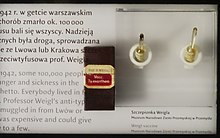Typhus vaccine
A typhus vaccine is a vaccine against the bacterium Rickettsia prowazekii , the causative agent of typhus .
properties
There are various typhus vaccines available, none of which confer immunity . Typhus vaccines are either formalin - inactivated or attenuated rickettsiae. While the inactivated typhus vaccine only provides short and incomplete protection, the attenuated vaccine (vaccine strain Madrid-E ) occasionally reverses to a virulent form ( Evir ). The reversion is based on a point mutation . The inactivated vaccine is usually given twice at four-week intervals and provides limited protection for six months.
One of the first typhus vaccines was developed in 1924 by R. Spencer and R. Parker. This vaccine was isolated from ticks that had previously sucked blood from infected guinea pigs, and the rickettsiae were then inactivated with phenol and formalin. Another early vaccine was made in embryonated chicken eggs ( Cox vaccine ). Both vaccines were tested in 1973 and with both vaccines, all vaccinated people developed disease. On renewed exposure, the disease was milder in both cases. Another inactivated spotted fever vaccine was developed by the US military ( USAMRIID ) from 1970 and produced in cell cultures from embryonic chicken fibroblasts .
Also in 1924, the Polish biologist Rudolf Weigl developed a vaccine made from rickettsia suspensions obtained from lice in the digestive tract ( Weigl vaccine ). This could not achieve immunity , but vaccinated people had a much milder course in the event of an infection. It is estimated that eight million Poles and Russians received the vaccine in the 1930s. Other spotted fever vaccines are the Castaneda vaccine from lung tissue from infected rabbits and an early vaccine from Hans Zinsser .
Individual evidence
- ↑ a b c d e f g D. H. Walker: The realities of biodefense vaccines against Rickettsia. In: Vaccine. Volume 27 Suppl 4, November 2009, pp. D52-D55, doi : 10.1016 / j.vaccine.2009.07.045 , PMID 19837287 , PMC 2909128 (free full text).
- ^ Y. Liu, B. Wu, G. Weinstock, DH Walker, XJ Yu: Inactivation of SAM-methyltransferase is the mechanism of attenuation of a historic louse borne typhus vaccine strain. In: PLOS ONE . Volume 9, number 11, 2014, p. E113285, doi : 10.1371 / journal.pone.0113285 , PMID 25412248 , PMC 4239044 (free full text).
- ^ RR Spencer, RR Parker: Rocky Mountain spotted fever: vaccination of monkeys and man. In: Public Health Rep. (1925), Vol. 40, pp. 2159-2167.
- ↑ HL DuPont, RB Hornick, AT Dawkins, GG Heiner, IB Fabrikant, CL Wisseman, TE Woodward: Rocky Mountain spotted fever: a comparative study of the active immunity induced by inactivated and viable pathogenic Rickettsia rickettsii. In: The Journal of Infectious Diseases . Volume 128, Number 3, September 1973, pp. 340-344, PMID 4199563 .
- ↑ John DC Bennett, Lydia Tyszczuk: Deception by immunization, revisited British Medical Journal 1990, Volume 301, Issue 22-29 . December 1990, pages 1471-1472
